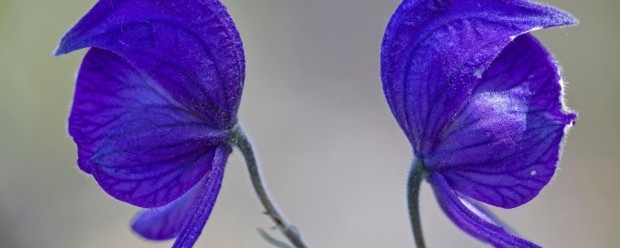Most venomous plants on Earth

BBC
In 2014, a gardener on a country estate in the UK mysteriously died of multiple organ failure.
The cause of his death remains unclear, but an inquest heard evidence suggesting he had been killed by a popular flowering plant, a member of the buttercup family.
The plant in question, called Aconitum, has blooms said to resemble monk’s hoods. But the plant is also known by other more sinister names; wolf’s bane, Devil’s helmet and the Queen of Poisons.
These do more than hint at its villainous reputation. For Aconitumis among the most deadly plants in the world.
The most poisonous part is the roots, though the leaves can pack a punch too. Both contain a neurotoxin that can be absorbed through the skin. Early symptoms of poisoning are tingling and numbness at the point of contact or severe vomiting and diarrhoea if it has been eaten.
In 2010, Lakhvir Singh was convicted of the murder of her lover after dosing his curry with Indian aconite. Apart from causing severe gastrointestinal upset, the poison slows the heart rate which can result in death.
But not every case is so unfortunate. According to former poison garden warden and expert John Robertson, our excellent vomiting mechanism means people can live to tell their tales.
“I’ve spoken to people that have eaten it and survived,” says Mr Robertson. “It was a couple that planted it to make their herb garden look prettier and when the wife was picking leaves for a salad she picked a few leaves of monk’s hood. They both had a pretty bad time of it for 24 hours but survived.”
The popular theory is that toxins have evolved in plants as a defence. In certain species, chemical compounds that are produced to fight off insect pests and other micro-organisms can do damage to big animals too.
This can be exaggerated by a phenomenom known as phototoxicity, where plant chemicals contact human skin and then react with sunlight, resulting in lasting burns. Giant hogweed (Heracleum mantegazzianum) has the worst reputation for it, but ‘friendly’ plants such as carrots, celery and limes can all blister the skin in the wrong conditions.
One of the worst untouchable species, whatever the weather, earns the dubious honour of being the world’s most dangerous tree. The manchineel (Hippomane mancinella) grows in northern South America up to the Florida Everglades and throughout the Caribbean. In some parts of its range it’s painted with a cautionary red cross.
The milky sap produced by this tree contains the powerful irritant phorbol. Just brushing past it can leave you with horribly scalded skin. Sheltering beneath it in a tropical shower can be disastrous too because even the diluted sap can cause an extreme rash.
Burning down these trees is also a bad idea. The smoke from a burning manchineel can temporarily blind a person and cause significant breathing problems.
While the effects are unpleasant, skin contact with this tropical tree can’t kill you. The real death threat comes from eating its small round fruit. Its common Spanish names means little apple of death. Ingesting the fruit can prove fatal when severe vomiting and diarrhoea dehydrate the body to the point of no return.
When it comes to plants that shouldn’t pass your lips, one rises above the rest, and it might be in your border right now. Ricinus communis is a shrub that is praised for adding a dash of summer colour to gardens with green to purple foliage, palm-shaped leaves and distinctive spiky seed capsules.
Castor oil, an acquaintance of anyone that needs to clear out their bowels in a hurry, is produced from the seeds of the plant. But the nervous, or nefarious, reader might have spotted an alarming keyword in the plant’s Latin-based scientific name: ricin. This is what earns the castor oil plant its reputation as the world’s most poisonous.
After the laxative oil has been extracted the remaining residues of its mottled brown seeds contain a potent cocktail of toxins. Ricin kills by interfering in cell metabolism, the basic chemical processes needed to sustain life. The creation of essential proteins is blocked, leading to cell death. Casualties can suffer vomiting, diarrhoea and seizures for up to a week before dying of organ failure.
The poison’s legend is polished by appearances throughout pop culture, from Agatha Christie’s novel The House of Lurking Death to the modern television series Breaking Bad. While fictional portrayals are obviously dramatised, it’s still pretty nasty stuff.
So how come we can freely grow this plant in ornamental gardens?
“There’s a difference between poisonous and harmful. You can say what’s the most poisonous plant fairly easily – theoretically looking at the toxins in it and what they can do,” says John Robertson.
“But whether that plant is then harmful is all about whether you’re likely to eat it, how easy it is to administer it etcetera.”
The outer casing of castor beans is often tough enough that, if swallowed whole, it can pass through the digestive system without doing fatal harm. You’d need to chew and swallow five castor beans for a lethal dose in adults, though perhaps just one in children. Ricin is most potent when its purified form is injected, as in the case of the Bulgarian dissident murdered with it in 1978.
A related poison, abrin is found with more of an obvious warning label. The seeds of the rosary pea (Abrus precatorius) are attractive bright ovals, often red with a black spot. Where they grow in tropical regions they are used to make bracelets, rosary necklaces or to adorn instruments. They even turned up in the shop at the UK’s Eden Project attraction in 2011.
Abrin is similar to ricin but reportedly more powerful in its pure form. Fortunately, the peas have a hard outer shell that often prevents the toxins being absorbed into the body. In one case where the ground powder of the seeds was ingested,rapid medical treatment led to a full recovery.
Fortunately, death by plant poison is pretty rare in the age of modern medicine thanks to quick diagnosis and good supportive care. And many plant-derived toxins have to be purified to be lethal.
So the plants might not be out to get you, but knowing how your garden grows could save your life.
How to submit an Op-Ed: Libyan Express accepts opinion articles on a wide range of topics. Submissions may be sent to oped@libyanexpress.com. Please include ‘Op-Ed’ in the subject line.
- Libya’s HCS invites applicants for key state roles - December 31, 2023
- UK calls on Iran to prevent escalation in Israel-Hamas conflict - November 05, 2023
- Libyan Interior Minister: Immigrant shelter costs a fortune - November 05, 2023


